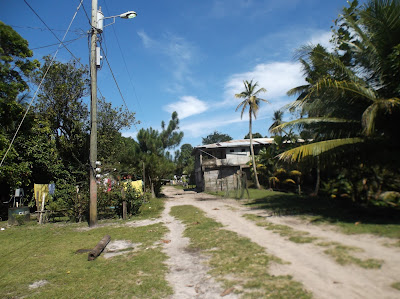Many people in the Atlantic regions still speak Spanish, however many do not speak it as their first language. Some speak either Creole which is a dialect of English, or Miskito which is an indigenous language of its own. Economically the Atlantic coast is far behind the Pacific. Many in the Pacific believe that people from the Atlantic coast are wealthy because the cost of living is higher, but the opposite is true, wages are generally lower while cost of living is higher. Having just moved to Jinotepe, Carazo we have found that prices of everyday household items like soap, as well as food are generally twice as expensive on the Atlantic coast, becoming more expensive the further east you go. Corn Island and Pearl Lagoon being the most expensive. This seems to be in part due to the lack of transportation. The highway stops at Rama, and any travel beyond there must be done by boat, or if you're brave by dirt (mud) roads. Another reason for the prices likely is the lack of competition, there are very few shops and no supermarkets besides the ones in Rama and Bluefields, so if someone is selling anything from the pacific they can charge any price they want even for basic necessities.
On the Pacific side of Nicaragua, first of all there's a lot more people. According to some sources 5% of the population lives in the two Atlantic Regions, and 95% in the Pacific. The Pacific is divided into many departments, all of which I have yet to memorize. We live in Carazo, other well known departments are Rivas, Granada, Masaya... names you have likely heard of. There is more business over here and many cities as well. Cost of living over here is generally 50% of what it is on the Atlantic side, although tourist areas may cost many times more. We pay a little bit more for rent over here, but that comes with conveniences that are hard to get in the Atlantic, such as wifi and hot water. We can even drink from the tap in Jinotepe, something we wouldn't even dream of doing in Pearl Lagoon.
 |
| Grocery store in Jinotepe |
Tourism has a much bigger impact on the Pacific side as well. On Corn Island (RACCS) tourism is only beginning, and any tourists found in Pearl Lagoon are either hard-core adventurers or hopelessly lost. San Juan Del Sur on the other hand, in the Rivas department of the pacific has a lot more in common with tourist hotspots like Cancun or Hawaii. many things are priced according to "If you have to ask, you can't afford it". Rental apartments or houses in SJDS are rare, as most opt to rent on a per-night basis and are unlikely to agree to long term. Other communities away from the beach are quite different however and rent can be very cheap. Although the Pacific coast may be more popular with tourists, the Atlantic has natural beauty that is beyond compare, just lacking in accessibility.
 |
| Sunset in San Juan Del Sur |
 |
| Crystal clear water of Corn Island |
Architecture on the Pacific side resembles the rest of Latin America. Cities are made up of blocks laid out on a grid, and the buildings in each block are built with their exterior wall immediately on the sidewalk, and their interior walls connected to each other, making the entire block resemble one large building.
 |
| San Marcos |
In the Atlantic however, houses are well spaced out and disconnected from each other. In fact, in smaller communities the houses may not even be built near a street, but rather be behind another house or simply standing on its own.
 |
| Haulover |
These are just a few of my observations, but it really feels like two countries in one, and if you spend any time in Nicaragua its definitely worth going to the other side to get the full experience.




No comments:
Post a Comment